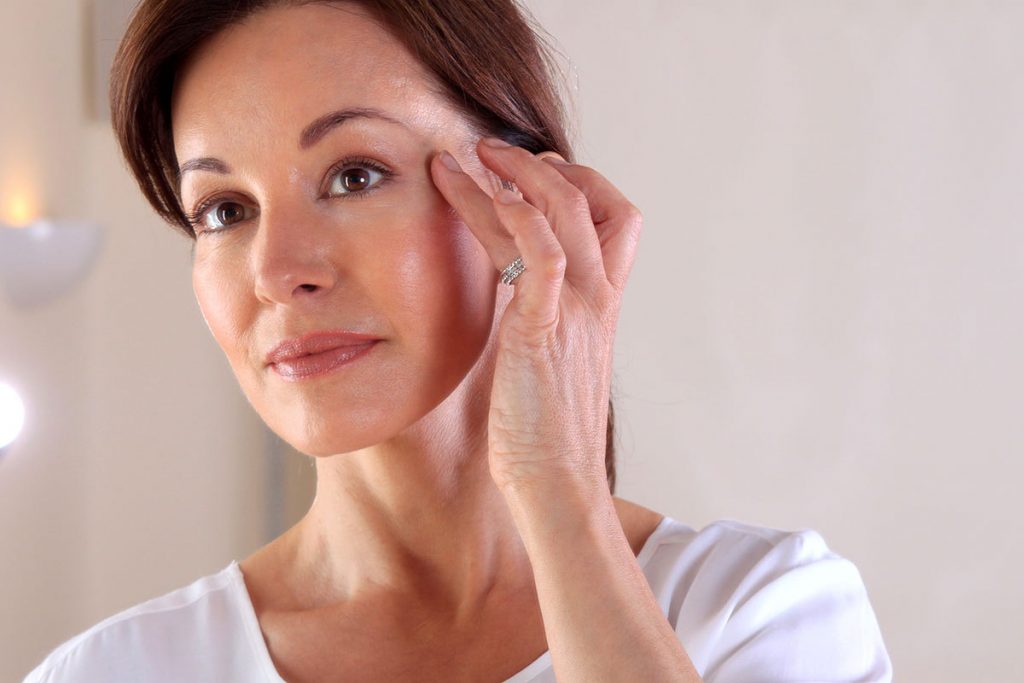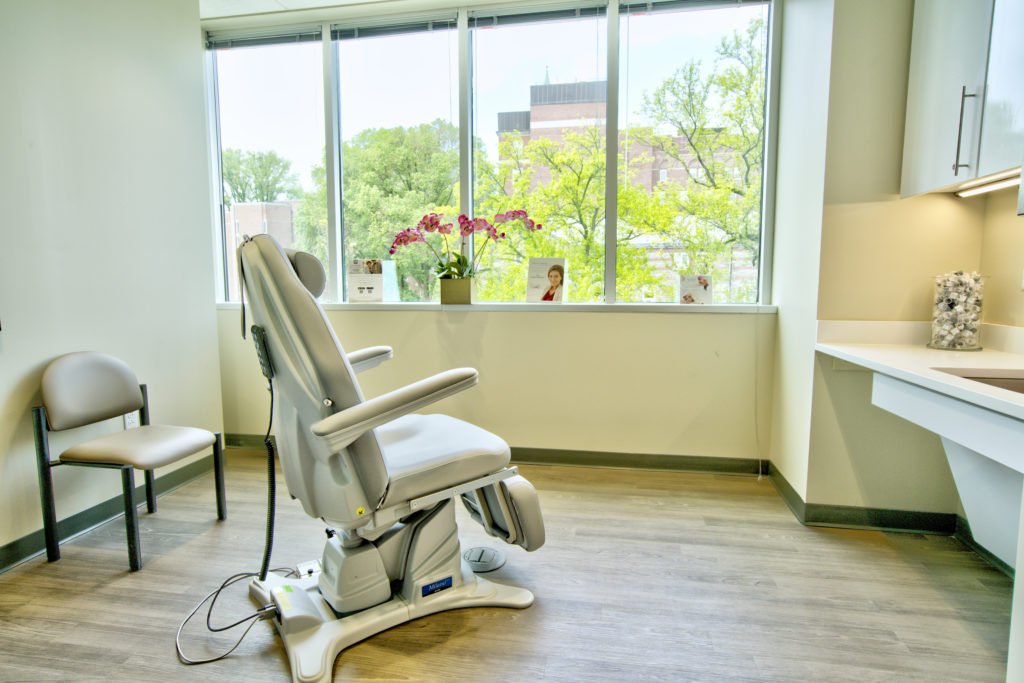
To help you understand how you can get ideal facelift results, we’re going to dive into the nuances of the subject. We’ll clarify what exactly is included in a surgical facelift procedure, the advanced techniques you should seek out, and finally explain what finishing procedures can be added to achieve the natural-looking results you desire.
What a facelift can and cannot do
The term facelift has come to be used as an all-encompassing term for facial rejuvenation, just as people use the word “Kleenex” for facial tissue. In truth, the term “facelift” has a very specific meaning for plastic surgeons. A traditional facelift is called a rhytidectomy and is a single surgical procedure that only addresses sagging skin in the lower two-thirds of the face, including jowls along the jawline and a sagging neck. The surgeon removes excess skin and repositions tissues in a more youthful position.
For some, a facelift alone is enough to provide satisfying results, but most patients have a set of interrelated concerns when it comes to facial aging. These are some areas a rhytidectomy will not address:
- Treating the eyelids or brow is not part of a traditional facelift. That said, many patients choose to have procedures for the eyes and upper face done during the same operation. Getting a natural-looking result may even depend on these add-ons: they help match the apparent age of your eyes and forehead with the lifted neck and cheeks a facelift provides.
- Another aspect of your appearance a surgical facelift will not alter is the skin’s surface. Here again, you can have a potential mismatch between your rejuvenated facial contours and skin that is wrinkled or sun-damaged. Skin resurfacing procedures and injectable neurotoxins like Botox may be called for.
- Lastly, a standard facelift will not restore lost volume. “Volume” in this case means the plumpness of your facial tissues, which is one of the primary ways we subconsciously judge a person’s age. While a facelift won’t help when it comes to this concern, youthful volume can be readily restored using injectable fillers or fat grafting.
Things you can do to get excellent facelift results
Choose a plastic surgeon who has experience with a range of facelift options
Surgeons who only know one way to perform a facelift are less able to adapt the procedure for various individual needs and anatomy. Therefore, you are best off choosing a board-certified plastic surgeon with experience in more advanced facelift techniques including SMAS Plication and Deep Plane Facelifts.
The Deep Plane Facelift technique allows the surgeon to lift tissues without putting tension on the skin, delivering longer-lasting, natural-looking facelift results.
The SMAS Plication Facelift builds on the traditional rhytidectomy procedure and includes moving the Superficial Muscular Aponeurotic System (SMAS) upward and laterally to better provide a defined jawline, tighter neck and a more youthful cheek volume. A Deep Plane Facelift is another variation that also treats the SMAS, but in this case, the SMAS is moved in a unit with the underlying musculature. This allows the surgeon to lift facial tissues without putting tension on the skin, delivering long-lasting, natural-looking results.
While you can only find out which version of a facelift is best for you in consultation with your doctor, choosing a plastic surgeon who is familiar with these advanced techniques will help you to get the best possible outcome.
Listen to your plastic surgeon’s advice when it comes to add-on procedures
While a facelift alone certainly can provide a refreshed look, if your eyes or brow look a decade older than your mid and lower face, it will create an unnatural appearance. The same is true for the surface of your skin. So, if a reputable plastic surgeon suggests additional procedures such as Fractional Skin Resurfacing or facial fat grafting, understand they are not simply attempting to “upsell” you, but rather working to achieve a complete and natural-looking result. If the cost of having multiple procedures is a concern, patient financing can be helpful.
Follow all pre- and post-op instructions to the letter
While much is in your surgeon’s hands, what you do before and after surgery will also play a part in your results. You absolutely must be honest about your health history, avoid certain medications and supplements, and adhere to all pre- and post-op instructions. After healing is complete, maintaining healthy habits and using a physician-only skincare regime can help you maintain your results. Your plastic surgeon may also suggest additional maintenance procedures; for example, BOTOX is a very effective way to keep unwanted expression-based wrinkles at bay.
Learn about facelifts for men »
Seeking a Deep Plane Facelift in Philadelphia?
Philadelphia-area plastic surgeon Dr. Claytor is well-known for his expertise in all areas of facial rejuvenation, including Deep Plane and SMAS Plication facelift techniques. We invite you to our office at (610) 527-4833 or contact us online to set up a consultation.

Double-board certified plastic surgeon Dr. Brannon Claytor and his aesthetic skincare team are sought after for the natural-looking results they achieve for their patients. One of their primary areas of expertise is treating facial aging. Today, we’re diving into alternatives to a full facelift procedure.
This is part two of our two-part series on facelift options: read our in-depth Q&A on full facelifts here in part one!
- Is there such a thing as a non-surgical facelift? »
- When a non-surgical facelift isn’t the right choice »
- What is ultrasound for the face? Is that the same as RF face lifting? »
- What are the best injectables for the face? »
- What is a mini facelift, or a short scar facelift? »
Is there such a thing as a non-surgical facelift?
Yes, from injectables to lasers to thread lifts, there are several non-surgical “facelift” techniques and treatments available. They fall into a few different categories and address different concerns. Read on to learn more about all of your options!
Treating volume loss with a non-surgical facelift option
As we age, our natural collagen production declines, and we lose volume in the midface. As we reach our 40s and 50s, the changes due to aging become more pronounced—even people with fantastic cheekbones will notice a difference in the padding above their bone structure as underlying collagen diminishes. There are a number of non-surgical treatments that specifically address volume loss.
Radiofrequency (RF) therapy treatments and dermal fillers are designed to add lost volume back to the face. Dermal fillers such as Juvéderm®, Restylane®, and Sculptra Aesthetic® are the most well-known options, thanks to their versatility and immediacy of their results.
Facial fat grafting (also known as fat transfer) is another way to provide a visible restoration of volume in the mid-face. This procedure doesn’t involve facial surgery; however, it does require minor liposuction surgery to harvest fat from elsewhere on your body.
Treating sagging facial skin without surgery
One treatment not many patients are familiar with is the Silhouette InstaLift, an advanced thread lift procedure our patients love. Medical grade suture material (thread) is passed under the surface of the facial tissue to pull up and tighten the skin. As the sutures dissolve over a six-month period, the process boosts collagen production, increasing firmness for up to a year.
Treating surface wrinkles without surgery
Rather than a full facelift, we recommend treating surface wrinkles with laser technology, skin resurfacing, or injectable neurotoxins. A surgical facelift is designed to lift deeper tissues and excise excess skin but doesn’t address fine wrinkles. So if fine wrinkles are your concern we have several options available:
Botox is heroic when it comes to treating expression based wrinkles—it’s been the #1 cosmetic treatment by far for over a decade. It can quickly soften the “11s” between your eyebrows, reduce crow’s feet around your eyes, and other expression-based wrinkles. If sun damage and fine wrinkles are your primary concern, then we suggest fractional laser resurfacing, an effective tool for renewing the skin’s surface.
When a non-surgical facelift isn’t the right choice
If you have a considerable amount of slack or excess skin, we recommend a surgical facelift as part of your treatment plan. It provides longer-lasting results and is a better option than overusing dermal fillers, which aren’t as effective for loose skin.
What are the best injectables for the face?
Injectables can give the face a rejuvenated, lifted appearance and effects can last for up to a year, depending on your goals and the product you choose.
Because they are so flexible and produce such natural-looking results, we love the dermal fillers Restylane® and Juvéderm®. They do their job using hyaluronic acid, which isn’t foreign to the body because our bodies produce it naturally. Sculptra Aesthetic® is another type of facial injectable made from poly-L-lactic acid, which helps replace lost collagen. You can use dermal fillers combined with neurotoxins, like Botox® or Dysport®, to further reduce wrinkles and smooth expression lines.
What is a mini facelift, or a short scar facelift?
A mini facelift, sometimes referred to as a short scar facelift, is done under local anesthesia and is most often recommended for patients in their 40s and 50s who do not have a lot of excess skin. This modified facelift procedure focuses on the lower third of the face, primarily lifting and firming jowls, sagging cheeks, and marionette lines.
The short scar procedure is also known as “ponytail facelift” because patients can pull their hair back into a ponytail without incisions being visible behind the ear. (Full facelift patients can also feel confident wearing a ponytail post-procedure—it just takes more time for traditional facelift scars to become unnoticeable.)
Learn more about facelifts for men »
Ready to rejuvenate your face? Our Philadelphia-based team has all the options you need.
Getting the best non-surgical facelift results often requires a range of treatment modalities. Based on their extensive knowledge of all the available options, Dr. Claytor and his med spa team are here to recommend the optimal products and techniques for you! Call the Claytor Noone Plastic Surgery office at (610) 527-4833 or contact us online to set up your consultation.
We look forward to welcoming patients on a limited basis, with new safeguards in place.
We hope that you have weathered this pandemic with your health intact. It has been stressful for so many. For us, it has also brought moments of joy and family proximity that we have not enjoyed in many years: two of our three children have been home with us for the past 8 weeks. We have cooked together, fished together, watched far too many movies, and even danced in the kitchen. We will miss them when all go their separate ways!
While maintaining the isolation mandate of Governor Wolf, I have also kept busy working as a member of the Aesthetic Society‘s COVID-19 Task Force. Our group has developed protocols to support a safe return to both the office and the operating room. As Chief of Plastic Surgery for Main Line Health, I have also spent countless hours meeting virtually with area plastic surgeons to create a cohesive plan to return to the business of caring for our patients.
Reopening the practice
The Governor is allowing physicians to once again open their offices beginning Monday, May 25th, and we are pleased to welcome you back!
Our first two weeks will be filled with surgeries postponed due to the mandate. We are also scheduling the following treatments beginning the first week of June:
- Botox and injectable fillers
- IPL, CO2, and Fractional Lasers
- Microneedling
In the near future, we also plan to offer facials, dermaplaning, and waxing with Jess.
If you have a question or concern about an upcoming treatment, Dr. Claytor or our nurses will conduct a brief virtual consult prior to the appointment. Please understand that, for the time being, we have very limited availability for new patient consults.
If you would like to schedule a non-surgical treatment or request a plastic surgery consultation, please call us at 610.527.4833 or contact us online, and we will respond as soon as possible.
Applying the highest safety protocols
Having helped to develop national and local protocols, we are both deeply informed and highly invested in maintaining the safety of both patients and staff. Before coming into the office, we request that you read the following requirements and adhere to them to help ensure your health and safety as well as that of our staff.
Our commitments to each other
- The week prior to your appointment, please take and record your temperature twice daily. (Surgical patients will additionally be required to take a COVID-19 test.)
- A nurse will call you prior to your appointment to review protocols, symptoms, and adherence to social isolation requirements.
- Everyone entering the office must be wearing a mask
- We will be scheduling one patient at a time so there is no overlap.
- No additional people will be allowed to accompany you inside.
- Please call us when you arrive at our address; we will ask you to wait in your car until we can receive you.
- You will be greeted outside of the office by Melissa or Gabby, our amazing nurses.
- You will have your temperature and finger test oxygen saturation taken before entering the office. We will also ask questions regarding symptoms.
- We will then escort you to the office and provide your service as safely and efficiently as possible, with the same great care you’ve always received.
- Your payment can be taken over the phone or online to streamline the visit.
It may sound complicated, but we are doing our best to ensure that you can have the same trust that you are safe in our hands that you have always had. Please let us know if you have any questions: you can call us at 610.527.4833 or contact us online. We look forward to serving you.
 Breakups are hard, but they can also pave the way to a better version of ourselves. When the breakup we’re speaking of involves bidding farewell to a cosmetic problem, there are only blue skies ahead. In our Bryn Mawr office, we help people feel like their best selves by tailoring cosmetic treatments to their needs. One of the common problems that can be addressed with plastic surgery but that we don’t often hear about is excess tissue on the upper arms. You may know this problem as “bat wings.” If you have this problem, you may be interested in arranging a breakup. We can help.
Breakups are hard, but they can also pave the way to a better version of ourselves. When the breakup we’re speaking of involves bidding farewell to a cosmetic problem, there are only blue skies ahead. In our Bryn Mawr office, we help people feel like their best selves by tailoring cosmetic treatments to their needs. One of the common problems that can be addressed with plastic surgery but that we don’t often hear about is excess tissue on the upper arms. You may know this problem as “bat wings.” If you have this problem, you may be interested in arranging a breakup. We can help.
What Is Brachioplasty?
Brachioplasty is better known as arm lift surgery. Interestingly, although it is not one of the better-known plastic surgery procedures today, it is one that has increased more than 5000% since the year 2000. The objective of an arm lift is to reduce the circumference of the upper arm to be in harmonious proportion with the lower arm. Weight loss and the aging process can affect this area by stretching and weakening tissue, resulting in a loose and saggy appearance. When the hand waves, the back of the arm does, too. Brachioplasty can correct this.
What Happens During Surgery?
An arm lift is an outpatient procedure that is conducted while the patient is under general anesthesia. During the consultation for surgery, the surgeon discusses the length and location of the incisions. Knowing that scars are a concern, Dr. Claytor places incision on the underside or the backside of the arms, where they are not obvious. To sculpt the arms, liposuction may be performed. This technique removes excess fatty tissue so the arm can be reduced nicely. After fat removal, the muscle is pulled taut and is trimmed as needed to achieve the ideal shape. Internal stitches hold the muscle in its new contour. These dissolve over time. The same thing is done with the skin. After trimming the excess, the surgeon places more stitches to close the external incisions. These may be removed approximately 10 days after the procedure. Bandages and compression garments may be placed over the upper arms.
Arm Lift Recovery
Patients return home to recovery and should be watched-over by a loved one for a day or two. Arm mobility will be limited for at least one week, and prescription pain medication may cause grogginess. By the end of week 2, comfort should be significantly improved. Mobility, however, remains limited for another few weeks. As long as no stretching or lifting is done, patients may return to most normal activities after their 2-week follow-up. Exercise and normal arm mobility may return by week six.
Free yourself to show off your arms this summer. Call our Bryn Mawr office at 610.527.4833 to learn more about arm lift surgery.

Aging eyes provide the fuel for frustration. We all know we will age. However, when the signs of aging change the way we look, we don’t have to like it. The changes around the eyes are particularly concerning because they don’t just make us look older, they change the expression of the face. We may look angry when we’re not. What’s worse is that we have no way to change this through normal facial expression. It all comes down to the heaviness of the eyelids and the tilt of the eyebrows.
As the concept of plastic surgery has become more widely accepted, people who are concerned about the condition of the skin on their eyelids and around their eyes are more likely to at least explore their facial rejuvenation options for addressing their concerns. Exploration often goes no further than learning what an “eyelid lift” is. This is because we assume that sad or angry-looking eyes must stem from the eyelids themselves. This isn’t so, which is why patients need to be informed about the differences between blepharoplasty and brow lift surgery.
Blepharoplasty
Blepharoplasty is the term that describes an eyelid lift. The procedure can be performed on either the upper or lower eyelids. In this instance, we are focusing on upper blepharoplasty. This technique is performed through a small incision in the upper eyelid, where it is hidden within the natural crease. The surgeon repositions and removes fat tissue as needed to smooth out the eyelid. Muscle tissue is manipulated along with the overlying skin. This restores the natural crease of the upper lid, which may have been hidden by loose, saggy tissue.
Brow Lift Surgery
A brow lift focuses on the position of the eyebrows. This facial feature should run along the upper orbital rim, the bony contour above the eyelid. Sometimes, the upper eyelids look heavy and saggy because the muscles that keep the eyebrows at their natural height have begun to slope downward. This pulls the overlying skin down and creates pressure on the upper eyelids. A drooping brow line can also result in a deep crease at the outer edge of one or both eyes.
Help for the Aging Face
To help explain the difference between upper blepharoplasty and a brow lift, we use the analogy of a long, dragging pair of pants. If the pants drag on the floor because they are too long, they need to be trimmed. This is much like blepharoplasty. If the pants drag on the floor because the belt is too loose to hold them up, the belt needs to be tightened. This is what a brow lift does to the muscles over the eyes.
Whatever the cause, the eyelids or the brow line, aging eyes can be an ongoing problem. To discover how eyelid rejuvenation can give you back the friendly face you once had, schedule a visit to our Bryn Mawr office at 610.527.4833.
 Many people know the name. Juvéderm represents a large family of dermal fillers, though the selection of various products is often simply known by the name of the brand itself. When people discover that their needs may best be met by one or more products in this family, they often express surprise. If all Juvéderm products are classified as hyaluronic acid soft tissue fillers, why is there a need for so many options? Here, we discuss the basics of Juvéderm as well as the details of each of the common products to help you understand which may be right for your needs.
Many people know the name. Juvéderm represents a large family of dermal fillers, though the selection of various products is often simply known by the name of the brand itself. When people discover that their needs may best be met by one or more products in this family, they often express surprise. If all Juvéderm products are classified as hyaluronic acid soft tissue fillers, why is there a need for so many options? Here, we discuss the basics of Juvéderm as well as the details of each of the common products to help you understand which may be right for your needs.
As a whole, Juvéderm is designed to introduce hyaluronic acid particles to the skin. Hyaluronic acid is a vital, naturally-occurring chemical that attracts and traps water molecules in tissue. It is necessary for the lubrication of joints, eyes, and for the moisture that plumps and smooths the skin. Hyaluronic acid restores water volume to the skin and, in so doing, can enhance the face in several ways.
JUVÉDERM ULTRA XC
The traditional Juvéderm filler is made with structured particle formation that reinstates a smooth foundation for the skin. This product has been used for years to eradicate moderate to severe nasolabial folds, the smile lines that form around the nose and mouth. It is also used to plump marionette lines that run from the outer corners of the mouth to the chin. The density of ULTRA XC is also advantageous in lip enhancement where more volume is needed in the body of the lips.
JUVÉDERM VOLBELLA XC
Volbella XC is a more recent development in which hyaluronic acid particles are cross-linked to achieve a particular consistency. This is referred to as Vycross technology. Vycross technology is also used to make Voluma XC and Vollure XC, which we will discuss here also. For Volbella, cross-linking modifies the molecular weight of the product to make it smooth and supple for natural-looking lip enhancement. Why choose Volbella when ULTRA XC is also for the lips? Because the two products have unique consistencies that make them good for particular concerns. Where ULTRA XC is used to add volume to the lips, smooth, silky Volbella is used to add definition to the edges of the lips. This product is also suited to the thin lines that form around the mouth.
JUVÉDERM VOLUMA XC
Another cross-linked hyaluronic acid gel, Voluma has a denser consistency that allows it to stay put in the deeper tissue beneath the skin. Voluma, as the name suggests, is made for noticeable volume in the midface. It can be inserted into the right areas of the cheeks to restore natural contour. In the area of the upper cheek, Voluma can smooth tear trough lines to reduce the appearance of undereye bags.
JUVÉDERM VOLLURE XC
Vollure XC is used much the same way as Juvéderm ULTRA. However, this product, with its Vycross cross-linking technology, is known for its moldability and flexibility beneath the skin. ULTRA is by no means stiff, but Vollure is simply smoother, providing elasticity and movement to areas around the nose and mouth.
Dermal filler treatment doesn’t have to be difficult to figure out. Our experienced injector can help. Schedule your consultation and treatment in our Bryn Mawr office at 610.527.4833.
It is sometimes frustrating to see the labels that are given to everyday problems. For the average woman, reaching orgasm can take monumental effort. So much effort, in fact, that “faking it” sounds like a better alternative than trying to force climax that just doesn’t seem to be forthcoming. Living with dissatisfying sexual experiences is bad enough. To then slap the label of “female sexual dysfunction” on top of the physical let-down of sex can inhibit a woman’s motivation to talk to her doctor even more.
We understand that it can be difficult to talk about a lackluster sex life, especially if you take full responsibility for this. And how can one not do this if her sensual sensations refuse to come along for the ride between the sheets? Listen, the clitoris may be one of the most highly innervated areas of the human anatomy to ever exist, but that doesn’t mean it’s always ready for action. Sometimes all it needs is a little help. We’ve got it in the form of the O-Shot.
The O-Shot insinuates orgasm, and that is exactly what it is meant to facilitate. The brief office treatment stimulates an increase of circulation and cellular activity right where it is needed most. Developed by Dr. Charles Runels, the O-Shot helps generate tissue and increase the sexual sensitivity. Until this treatment was developed, most protocols were devoted to men’s sexual function. However, more than 40 percent of women struggle with adequate sexual stimulation. In a 20-minute treatment process, this can all change.
How the Treatment Works
O-Shot treatment can be performed by Dr. Claytor or our nurse injector who has been fully trained. To determine where the injection would make the most impact, the doctor or nurse “maps” the vagina and clitoris.
We know what you’re thinking. Getting a shot of anything in the vaginal area must be painful. As sensitive as this area seems, it is generally easy to numb with only a topical anesthetic. The patient may sit with numbing cream in her clitoral area. By the time injections begin, the nerves are nicely desensitized. Most patients feel nothing at all. Some feel a tiny pinch but nothing more.
The results of the O-Shot may begin to manifest right away. Patients can drive home right after treatment and resume all normal activities, including sex. Initially, the clitoris may feel slightly swollen (not a bad thing in the least). As this fades, tissue regeneration and circulation work synergistically to enhance physical sensation. Sensation can increase so substantially that women report having orgasms when they couldn’t previously.
Sexual health is an important aspect of life that we shouldn’t be afraid to discuss. If you would like to know how the O-Shot could help revive your sexual enjoyment, call our Bryn Mawr office at 610.527.4833.
 The face is an expressive part of the body. It gets attention for the emotion that it demonstrates, even when we aren’t trying. Many people realize that the face is a feature that we “read” to gain information about one another. The information that is gained has a lot to do with the shape of the mouth and the expression of the eyes. Aging changes both. As the skin on the upper and lower eyelids loses resiliency and firmness, the eyes don’t just look older but they can also look unfriendly or angry. Blepharoplasty is a procedure commonly performed to correct these problems and revive the friendly vibe of the face. If blepharoplasty is on your radar, you may have common questions that we’ll try to answer here.
The face is an expressive part of the body. It gets attention for the emotion that it demonstrates, even when we aren’t trying. Many people realize that the face is a feature that we “read” to gain information about one another. The information that is gained has a lot to do with the shape of the mouth and the expression of the eyes. Aging changes both. As the skin on the upper and lower eyelids loses resiliency and firmness, the eyes don’t just look older but they can also look unfriendly or angry. Blepharoplasty is a procedure commonly performed to correct these problems and revive the friendly vibe of the face. If blepharoplasty is on your radar, you may have common questions that we’ll try to answer here.
The Best Age for Blepharoplasty
Many patients ask if they are the right age for blepharoplasty. We do not determine candidacy for eyelid rejuvenation based on biological age. What is much more relevant is how the skin has aged. A person who is in their forties who has sustained a moderate amount of sun damage around the eyes, for example, may be just as good a candidate for blepharoplasty as a sixty-year-old who has shielded their skin behind sunglasses and hats all their life. Statistics suggest that younger patients often undergo blepharoplasty as a sole procedure, whereas older patients include blepharoplasty into a broader treatment plan that addresses the signs of aging around the eyes as well as across the mid and lower face.
Blepharoplasty Scars
Although blepharoplasty is performed to improve the appearance of the eyes as a whole, there is the matter of scars to consider. Fortunately, lower blepharoplasty does not incur visible scars due to the internal location of incisions. Upper blepharoplasty incisions are located in the natural crease of the lid. Here, resulting scars are only visible when the eyes are closed. Furthermore, because the skin here is so thin, scarring is typically so minor that it is only visible when observed very up close. Basically, no one should see blepharoplasty scars unless they are looking for them.
Are the Eyelids the Only Problem?
Sagging, heavy upper eyelids are a problem that can fatigue the face. Because the eyelids themselves look hooded, it is reasonable to assume this is the ideal area for correction. This isn’t always the case. Sometimes, the upper eyelids become hooded because the tissue is being compressed by the skin and muscles of the forehead and brow area. If you have deep crow’s feet and sagging skin at the outer edges of your eyes, you may be a candidate for a brow lift. This procedure can be performed independently or in combination with blepharoplasty to achieve beautiful, natural-looking results.
We enjoy helping our patients feel like their best selves. To learn more about blepharoplasty eyelid rejuvenation, call our Bryn Mawr office at 610.527.4833.
Breast augmentation may be one of the leading plastic surgery procedures performed in the past several years, but that does not mean the choice of implants is easy for every patient. In fact, one of the most common questions patients ask is whether saline or silicone implants are right to address their small breast size. The answer is different in every situation, and it has more to do with personal preference than anything else. Here, we point out important details about each type of implant to help you begin to make your decision. Ultimately, however, the best way to know which implants you will prefer is to schedule a consultation with a trusted plastic surgeon.
What to Know about Saline Breast Implants
Saline breast implants are composed of a silicone shell that is filled with sterile saline once it has been inserted into the breast pocket. Patients who choose this type of implant typically do so for one of three reasons. They may be too young for silicone implants (approved for age 22 vs. 18 for saline implants). They may prefer the lower cost of saline implants, or they may feel safer knowing that a saline implant will deflate if it were to rupture.
Look, Feel, and Durability
One of the potential downsides of saline breast implants is that they typically feel firmer than silicone. This is due to the extent of filling within the silicone shell. In terms of durability, saline implants are comparable to silicone devices. If deflation occurs, the problems can be quickly dealt with by replacing the ruptured implant. Patients appreciate the fact that saline that leaks into the body gets absorbed without adverse reaction, whereas a silicone leak could present concerns.
Silicone Gel Implants
Silicone breast implants are pre-filled with a silicone gel before placement in the breast pocket. They also have a silicone outer shell that is made to withstand the normal pressures that may be placed on the chest. Several different silicone implants are available today, with each offering a varying degree of cohesiveness than others.
Look, Feel, and Durability
Silicone breast implants are known for their natural look and feel. Not just how the breasts feel to the touch, but how they feel in the body when moving or lying down. This is an important detail that patients should be aware of as they make their decision about the right implants for them. Like saline implants, silicone breast implants are made with strong outer shells that are intended to contain silicone gel for many years. The safety concerns that may have been raised by the recent recall can be alleviated knowing that only a small number of a certain textured breast implant model were involved. To date, most studies indicate that silicone breast implants are safe for most women.
If you’re considering breast augmentation, schedule a consultation that will provide you with the details you need to make the best decision for your needs. We’re happy to help. Call 610-527-4833 to schedule a visit to our Bryn Mawr office.
 We give so much attention to the signs of aging on the face that we may overlook the appearance of the chest. For many people, this could be a mistake. When we conduct treatments to keep the face looking fresh and young, we do a disservice by leaving wrinkled, sun-damaged chest and neck skin alone. The problem with chest wrinkles and sun damage is that these problems have been notoriously difficult to correct. The skin here is not only susceptible to hyperpigmentation and sun damage but it also gets thinner with age, making it appear crepey.
We give so much attention to the signs of aging on the face that we may overlook the appearance of the chest. For many people, this could be a mistake. When we conduct treatments to keep the face looking fresh and young, we do a disservice by leaving wrinkled, sun-damaged chest and neck skin alone. The problem with chest wrinkles and sun damage is that these problems have been notoriously difficult to correct. The skin here is not only susceptible to hyperpigmentation and sun damage but it also gets thinner with age, making it appear crepey.
Recently, we’ve come across several ways that the chest and neck skin can be supported and also corrected when necessary. On the store-bought end of the spectrum, consumers offer rave reviews for professional-grade silicone pads that adhere to the skin during sleep. As soothing and replenishing as these products can be, they are not capable of correcting the damage that has already been done. But there are other options, and we’ve got them.
Lasers
Doctors used to use strong CO2 laser devices to obliterate the top layers of a patient’s skin. The rejuvenation achieved with this practice was substantial but so was downtime and risk. We prefer a gentler approach. While patients with minimal sun damage may benefit from IPL treatments on the chest and neck, more significant improvements are achieved with fractional laser resurfacing. Fractional lasers spread energy out into tiny pinpoints rather than one concentrated beam of light. This disperses energy across the skin for a gentler but no less effective resurfacing process. A few treatments may be needed to achieve dramatic results, depending on the degree of damage that has occurred. However, patients can resume most normal activities right away after fractional laser treatment.
Radiofrequency
Where lasers are often used to address issues like sunspots and tissue thinning, radiofrequency is often a go-to for tissue laxity. Like laser treatments, a radiofrequency treatment sends precision energy into the dermis. In the case of radiofrequency, the energy that gets absorbed heats collagen strands to the point of contraction. Additionally, cells are stimulated to produce more collagen and elastin, proteins that replenish the skin’s foundation. A series of radiofrequency treatments can smooth and firm the skin to look healthier and younger.
Remember all the parts of you that could give away your age. For more information about facial rejuvenation and treatments for the neck and chest, call 610-527-4833.

